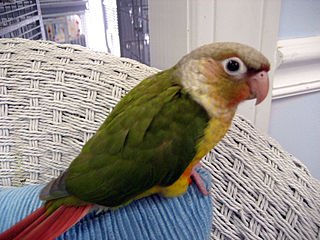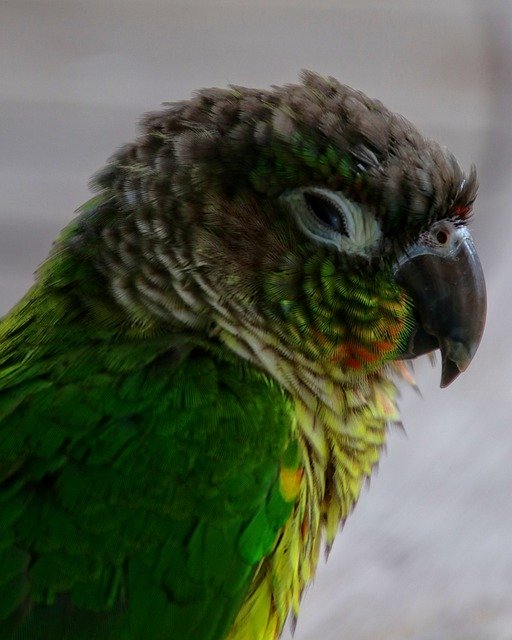Blue-throated conures are native to Eastern Brazil. The Latin name for Blue-throated Conure is Phyrrhura Cruentata and they are sometimes also called Red-eared Conure. This charming green bird has a perfect color variation on his body. Owing to their small size of around 15 inches and minimal weight of just 90 grams, they prefer to dwell in the forest lowlands.
In the wild, they can be seen in flocks of around 10 to 20 parrots. They love nesting, especially in the canopies of humid forests. They are forced to feen in plants and damage the crops while eating. This makes them a rare bird in captivity. But the small size, wonderful coloration, quiet nature, and ease of care make them a very good pet. Their trainability makes them a great learner, that is another plus for him being an ideal family pet.
Blue-throated Conure Lifespan
Blue-throated Conure lives for 6 to 8 years in the wild. However, in captivity, they can have a lifespan of 25 to 30 years courtesy dedicated care and attention to them by their human companion.
Blue-throated Conure Personality
Blue-throated Conures are smaller than other conure species. But they share many personality traits with their cousins. They are strong flyers and need space in the aviary. Blue-throated Conure has inquisitive nature and hence, is easily trainable. Besides, they love to cuddle and sometimes play silly.
Little is known about the personality of a blue-throated conure as they are rarely bred and more so, petted. But here are a few personality traits that have been affirmed by some of the owners:
Playful- Blue-throated conure has a playful personality and is happy and content if he gets to play and have fun all day long. For this, it is always good to add enough toys to his cage area. Climbing ropes, toy ladders, and mini gymnasium are just a few good examples. They are just a few good references to start with the options are galore.
Cuddly- Blue-throated conures are defined as cuddly by their owners. But the only prerequisite is a great bond with them. Once the bird feels connected with his favorite human courtesy some ‘me-time’ with the bird daily, the bird doesn’t shy away from riding your shoulders or arms or playing peek-a-boo when let out of the cage. Additionally, to help feed their snug behavior inside the cage, add a small fleece or warm hut hung from the cage’s ceiling.
Intelligent- They have been believed to be an intelligent parrot species owing to their speech learning ability. Many blue-throated conure owners accept the fact that their bird learned the words quickly when taught with an apt technique and training. The only reason that this fact is not widely acclaimed is the scarcity of blue-throated in the pet world.
Blue-throated Conure Colors
Blue-throated Conures are loved for their unique colors. Most conures lack vivid color patterns. However, blue-throated breaks the pattern with his mesmerizing plumage.
Forget the variety of colors on their body, their face alone seems like a beautifully painted canvas. The head of the bird is black. While the cheeks are burgundy red, this burgundy red turns into a light peach as it reaches the back of his neck. The frontal neckband is green and the sides of the neck are yellow or orange.
Another unique color feature of the blue-throated is the turquoise color on the chest bend. A deep crimson red color is seen on the belly and tail. To be spotted from afar, the bird also features two orange spots on the top of their wings. All these beautiful colors make them a sight to behold for a viewer.
Blue-throated Conure Behavior
The blue-throated conures are believed to be gentle and calm natured. Apart from normal hormonal changes during the breeding season, they can hardly be seen in an aggressive state.
Affectionate- Not much has been documented about the behavior of a blue-throated conure in captivity. But whatever little has been known and approved by their owners is their affectionate behavior almost always. Blue-throated tend to be gentle towards their favorite human once a close bond is formed.
That said, there has not been much evidence about their behavior during breeding seasons. Most of the parrot species tend to experience bouts of anger towards their mates and human companions.
Blue-throated Conure Breeding
Blue-throated conures breeding season starts from June and ends in October.
In the wild, the hen conure nests in the cavity of a tree. She mostly lays 3 or 4 eggs. Incubation is done by both parent parrots for around 24 days. The young fledge in 10 weeks in the wild. Baby parrots are found 5 to 6 grams in weight
In captivity, Blue-throated conures love to sleep in their warm and cozy nest box with the dimensions of 10″×10″×28″. So, it is always advisable to have a nest box placed along with the cage. This nest box requires regular cleaning and maintenance. The nest box should always be fitted with a wooden ladder for the bird to have comfortable access.
In the breeding season, a healthy diet that induces hormonal changes must be fed to the pair. Serve sprouted seeds, fruits, and vegetables twice to the blue-throated conures to enhance the chances of breeding and reproduction. But a DNA test is required before attempting breeding on a conure pair. One cannot tell if the conure is male or female, just by looking at him.
Blue-throated Conure can be hard to breed if a compatible pair is not found. They need space and seclusion to bond. Finding a compatible pair from a breeder is always a solution for easy breeding.
Blue-throated pets are seen rarely in captivity. This could be attributed to their less number. But they are considered as great pets as:
– They aren’t as loud as many other conure species like green-cheek or sun conure. This has made them earn a little fame among apartment dwellers as their voice hardly surpass the walls to disturb neighbors;
– They have an affectionate and gentle disposition and thus, proves to be an easy-going pet;
– Lastly, they tend to bond well if given enough time and attention.
Blue-throated has been declared Vulnerable as per the IUCN Red List of Threatened Species. The primary reason for this is the loss of their natural habitat and thus, their decreased breeding. Also, the species is rare in international markets which makes their breeding impossible in non-native regions too. However, many conservation efforts have been put in place successfully to increase their numbers.
Blue-throated Conure Talking Ability
Blue-throated conures possess average talking abilities. Though they aren’t as talkative as other conure species, they can make quite a few calls and loud whispers. They don’t believe in talking too much as they are a limited talker and vocalizer. They often mimic a girly voice because of the ease. A woman’s pitch is easier said than a man’s. They make the chirp calls, tweet calls, and screech occasionally.
Are Blue-throated Conures Noisy?
No, Blue-throated conures are not at all noisy. They are ideal for small apartment owners as they aren’t believed to make noises to annoy neighbors. They make loud noises in the morning and evening but these are a few-second contact calls that aren’t likely to be audible next door. They don’t sound annoying or irritable to the listeners. That said, blue-throated conure occasionally makes screeching calls when irritated. Providing enough entertainment is the key to prevent such untimely screeches. But other than this, the calls are normal including chirping and tweeting.
Blue-throated Conure Gender Difference
To determine the gender in blue-throated conures, the only sure-shot way to be accurate is DNA sexing. Blue-throated Conure males and females tend to have identical features, just like other parrot species of conure family, i.e. they are monomorphic. They don’t differ in appearance at all. With time and expertise, an experienced breeder may tell the difference but only scientific testing can testify it.
To check the gender of the bird by DNA sexing, tests can be performed either from the blood sample, or the feather samples, or both. To perform the test, nail clippers and DNA test cards will be required. One can take the sample by himself carefully or ask a professional veterinarian.
For the blood sample, the toenail of the bird is clipped by the nail clipper. This minor cut will deliver a few drops of the conure’s blood. The test performer is required to collect these drops on the DNA test card. Lastly, he can submit the card to the lab for testing.
For the feather sexing, about 5 feathers are plucked and placed in the resealable plastic bag provided by the testing agency. The feathers must be collected from the breast area and sent for the sexing test to the lab.
Blood clotting medications must always be kept handy at the time of taking samples.
Blue-throated Conure Diet
Diet of a blue-throated conure includes several nutrients, vitamins, and minerals. They love to eat healthily both in the wild and during captivity. Feed them a healthy diet supplemented with multiple fruits, vegetables, seeds, nuts, dry fruits, and millet spray.
Fruits loved by blue-throated are oranges, apples, bananas, pears, kiwi, pomegranate, star fruit, pumpkin, corn on the cob, passionfruit, and guavas. Offer them a mix of a few of their favorite ones daily. Keep rotating them to make a different mix each time. This will keep the bird’s interest piqued for his next meal.
Vegetables include carrots, pumpkins, winter squash, leafy greens, green beans, and celery. One can boil the carrots and then cool them down before serving to the bird. This makes it easier for the bird to chew it. Serve these veggies sliced, diced or pureed to make it eatable for the bird. Always discard the uneaten fruits and vegetables as they might have contracted the growth of bacteria.
Offer them a healthy and varied seed mix daily. Soak the seeds to make them easy to chew. Try to offer a homemade seed mix like millet, quinoa, chia, safflower, sunflower, etc. rather than a processed store-bought mix. And to cover up for any loss of nutrients, serve a high-quality pellet formula daily.
For the occasional treats, offer them nuts and dry fruits in small quantities. One can add peanuts, pine nuts, walnuts, almonds, brazil nuts, and pecans to a blue-throated diet. All these nuts are best served after removing their shells. Some blue-throated also like a little cheese or dairy occasionally. Pasta and rice are other favorite treats of theirs’.
In the breeding season, they may need calcium supplements to synthesize eggshells. Add a cuttlebone and mineral blocks to their diet. The best way is to hang them inside their cage or keep them on the floor.
However, avocado, rhubarb, and onions are to be avoided at all costs. Chocolate, salt, caffeine, alcohol, sweets, and food scraps should also not be served to a blue-throated conure. Also, an overdose of anything can harm him. Nuts and seeds are fattening and should only be served in a small quantity.
Lastly, keep a regular supply of freshwater for the bird inside his cage. The best way is to fill a water dish and hang it inside the cage with a clipper. Alternatively, place the bowl on the cage floor. Do not forget to refill the bowl regularly after cleaning it.
Summing Up
Blue-throated Conures are wonderful parrots. Their unique colors and adorable nature make them an ideal pet. They don’t live much in the wild but in captivity, they can be a companion for a longer time. All they need is a little attention and a lot of care and they commit their loyalty to their human companion for the rest of their lives.





